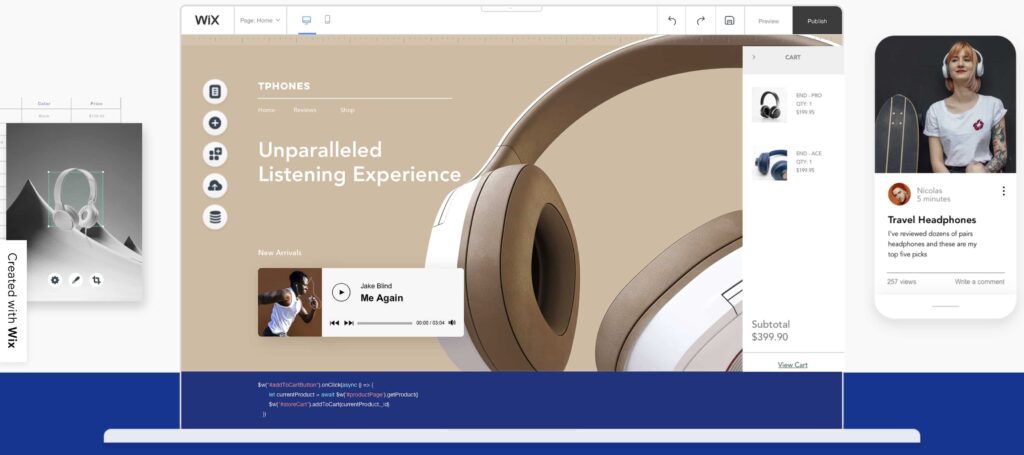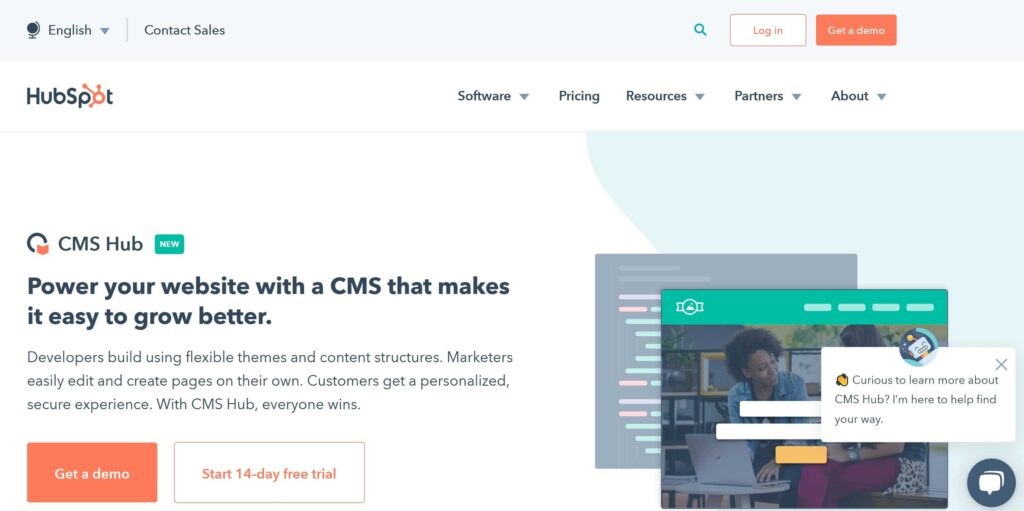An effective website will serve as your digital outlet and online business card. Consequently, you need to know what the best content management systems are.
This is basically the venue that will leverage all your other content marketing channels.
Statistics show that marketers prioritizing blogging are thirteen times more likely to gain from positive ROI. Why you may wonder? Because marketers have learned that people will visit social media mostly for entertainment but check on Google (websites and blogs) for solutions to their problems.
The platform that you use must therefore be flexible enough to keep evolving with the changing times in order for your content to offer solutions at the right time and to the right people.
When it comes to the best CMS there’s no one-size-fits-all, you only need to identify the one that offers all the features that you need to build a successful website.
Let’s Make Your SEO & Content Work Better for Your Business
What Should You Look For in the Best Content Management Systems of 2023?
All blogging platforms available come with different learning curves.
If you are just starting, as a beginner with zero technical background, you’ll want a straightforward content management system. As you grow with your blog you may want to add more features or customizations to maximize its effectiveness.
Blogging platforms can be classified into two categories:
i. Content Management Systems (CMS)
This is software hosted on a server and requires a connection to a domain name that you have to buy. CMSs offer endless possibilities although they come at a cost. They allow you all the freedom to customize as you please, especially if you know your way around deep technical stuff.
ii. Blog Publishing Services
This is a platform where you sign up to create your blog; meaning you do not need a server. Plus, you use the sub-domain of the hosting platform. Obviously, it is easier to use particularly if you’re not coding savvy and when you want to spend almost zero to set it up.
With that said, the best blogging platforms in 2023 will include a perfect mix of both categories mentioned above together with the following basic features:
a. Text editing functions – A good platform must offer a wide variety of inbuilt editing options. For instance, it should offer an auto-save function, a preview function, or even a basic grammar editor.
b. Customization – A great platform must offer you themes and templates you can play around with to give your blog the look you desire. Some platforms offer a variety of templates for free while others offer them at a premium rate. Others will allow you to create from zero if you don’t like any of the offered themes. So, what you pick will depend on your needs and your technical know-how.
c. Comments function – an engaging comments section is what helps grow your blog. This feature must therefore be enabled and be as interactive as possible.
d. Scalability – As your blog grows; you want a platform that will handle all the content without slowing it down, so you can keep growing without limiting your potential.
e. SEO tools and features – You obviously want traffic to your blog. Optimizing your content for search is therefore of absolute importance. So, you need a platform with inbuilt optimization tools to help you optimize your content. Some platforms offer you SEO suggestions as you type, this is what you need. Alternatively, if your ideal platform does not offer this tool, you can install third-party tools or plug-ins. If all this is not available, use the SEO best practices skills you have to create your content.
f. User-friendly – When starting, you really need a simple-to-learn and use platform, whether you’re a developer or a rookie. Thus, pick a platform that’s less complicated but gets the work done and gets going.
Other things to consider when picking the best blogging platform include the purpose of your business, your goals, as well as your needs. Your niche is another key element that you want to consider. For instance, if you prefer visual content, then you want to consider platforms that support multi-media content. If you prefer social, then you want to consider a platform that supports social media and so on.
Without further ado, here are some of the best content management systems for 2023 in detail:

Visuals are the first vector of sales.
Use Professional Styled Stock Photography to Promote Your Business.
The Best Content Management Systems
1. WordPress – The Best CMS for Websites
The 2023 statistics show that WordPress powers 39.6% of the internet. Launched way back in 2005, this is by far the most flexible content management system that has evolved into a multi-purpose CMS with loads of features and themes. It offers both free and premium services. Basic blog hosting is free while additional features such as extra storage or a custom domain name come at a fee.

Source: Hostingtribunal
The flexibility mentioned above comes to play when you have to configure your blog according to your taste. This includes picking a theme from the hundreds offered, the fonts, the plug-ins, and so on. For a newbie or someone that’s not a developer, this may take quite some time to get done. However, it pays off when you get used to it.
WordPress prides itself on a thriving community that offers quick solutions to any challenges you may experience and offers expert support when that’s what you need. They also take care of all your security issues and accept credit card payments through an available plug-in. It’s therefore a great platform with unlimited potential for growth.
The price starts at $4 monthly for personal plans but there is a free version for non-commercial blogging. The free-for-life plan includes a subdomain, community support, jetpack essential services, and dozens of free themes.
It’s free of charge if you don’t mind the sub-domain. If you do, you can install and run your own WordPress website.
Pros or Why WordPress Is the Best CMS?
· You get thousands of plug-ins and add-ons for free or as premium plans.
· The learning curve is not very steep, and you get support if you experience any issues.
· You can build a website on WordPress because it’s open source, meaning you can use a developer to make it according to your wish.
· As indicated earlier, it offers great flexibility and can handle any size of the content.
· It’s free of charge if you don’t mind the sub-domain.
Cons
· For non-developers, launching it can be quite a burden that may take some time.
· It’s impossible to run ads on your blog, WordPress just runs them free on your free plan.
· Your blog belongs to WordPress and they can therefore suspend your account if they find you guilty of violating their terms of service.
· You are limited on how much you can extend your site; you may not be able to use some plug-ins and themes.
Who can use WordPress?
· Online businesses
· Professional bloggers
· Anyone that simply wants to have full control of their website.

Visuals are the first vector of sales.
Use Professional Styled Stock Photography to Promote Your Business.
2. Wix
Launched in 2006, Wix was initially meant for building websites, but it has a blogging segment. It’s one of the most popular content management systems because of one simple reason: it’s incredibly easy to use. The easy drag-and-drop tools enable you to add items to your blog or website.
So, for beginners or non-techies, this is one of the best CMS. If you’re a developer, you have the option of starting from scratch and building your customized blog or website.
It has over 500 templates that are categorized into hobbies such as crafts, e-commerce section, and personal section. Another unique feature of Wix is that the blog you create on this platform is supported on mobile devices such as tablets or smartphones. Thus, your readers can easily access your content on the go.
They propose a wide selection of templates and designs, you’re able to add your own captions and links to images, and you’re able to insert videos from either Vimeo or YouTube and it’s also possible to personalize your image galleries.
When it comes to editing, as said above, Wix is great on mobile, so, you can actually update your blog from your mobile device. Isn’t that just great?
You can monetize Wix by adding custom ads via HTML elements, however, on the free plan, branded Wix elements will be shown too. In terms of support, they have a strong customer support system that helps you out whenever you have an issue, via phone or email.
Both premium and free plans allow you to launch a blog from your Wix site. However, if you want to use your own domain name, you’ll be required to sign up for a combo plan for $13 per month. And this will spare you from all the Wix ads.
Pros
· They offer dozens of templates that you can customize.
· They offer built-in stock of free videos and photos.
· They allow you to build your site from scratch or use templates, it’s your choice.
· It’s very easy to set up using the drag-and-drop tools.
Cons
· The free plan is quite limited and shows Wix ads on your site.
· Third-party apps are limited.
· It’s difficult to change a template once you choose.
· The e-commerce tools are only limited to the premium plans and even then; they’re still a little limited.
· In comparison with other content management systems, the features they offer are rather limited.
Wix pricing of the premium plan starts at $8.50 per month, but you can add a custom domain for $4.50 per month.
It’s best for professional bloggers and also for business-centered blogs.

3. Medium
This platform is a community of great writers, journalists, and bloggers among other experts and it continues to grow in popularity, especially because of the few features that make it an easy-to-use platform. For instance, its sign-up process is just like that one of a social media platform. You just create an account and get started there and then.
The first thing that you might notice with this platform is that you can’t have your own domain. Instead, you’ll have a URL like https://medium.com@youraccountname.
Launched in 2012 by Evan Williams, co-founder of Twitter, Medium is mainly focused on your content rather than your brand. Meaning you can create content about your brand and customize your layout by adding your logo, your headers, or brand colors. In terms of personalizing your account and content that’s about all.
As a publisher, this platform is absolutely free of charge and it will help you reach like-minded people who take your content seriously without being distracted by ads because Medium has no ads.
With that said, readers do pay a subscription fee to be able to get customized top-rated content. They’re charged $50 per year, so when you get many readers applauding your work, you get paid and this money is from the readers themselves.
Medium has a partner program and once you sign up for it, your publications are reviewed by Medium’s editors if your content is stellar, they recommend it to subscribed members and that’s how you get a chance to earn money.
When it comes to editing your content, it offers a pretty clean drag-and-drop easy-to-use tool. Your work and any changes you may make are automatically saved and as you proceed typing, you get to see how your completed post will appear to your readers.
It truly is the minimalist of all blogging platforms when it comes to design, it’s a size that fits every average blogger. They want you to focus on the written words with zero distraction.
Who should best use Medium? Anyone who loves words and has a flair for them. This is the best free blogging platform out there.
Pros
· You have over 60 million word lovers waiting to read your content
· Offers a brilliant typography with a completely professional look
· Business friendly
· Monetization option with the Partner Program
Cons
· Almost no customization, all blogs have the same look
· You can’t link to a Google account to get Analytics.
[interact id=”5b8ed2e728483b00147dabf7″ type=”quiz” mobile=”false”]
4. Blogger
This old spot is one of the best blogging platforms out there. It’s a free blogging platform simple enough that anyone can use it with ease. If you already have an existing Google account, then you already have a Blogger account that comes with a domain name, if you want your custom domain name, you have this option available.
It offers a wide range of templates that can be personalized. And since it belongs to Google, it integrates very easily with other Google tools such as Google Analytics, Google AdSense which will enable you to monetize your blog by displaying relevant ads on your pages.
Plus, it allows you to edit HTML, and add images and widgets to your blog, something that’s not very popular with other blogging platforms.
With this said, it can be a little limiting as far as basic tools are concerned: it doesn’t allow you to add new features and you’re restricted with few design options. It’s pretty retro. Another limiting factor about Blogger is that it caps the number of characters you can use (does Twitter come to mind? Guess who founded both?)
If for any reason you get stuck and need help, you won’t get much help here. They have no support system. And since Google is known to kill their products, it means your blog will be vulnerable to whatever decisions they wake up to.
Pros
· It’s absolutely free and user friendly
· Does the hosting and maintenance
· Offers templates you can pick from
· Easily integrates with other Google tools and products
· It has a good anti-spam tool
Cons
· Doesn’t offer many blogging tools or designs
· Integration with third-party apps is nil
5. CMS Hub
This is one of the best content management systems in 2023 particularly because of its full integration with HubSpot’s marketing tools, a built-in CRM, and other service tools. It allows you to customize your blog as you wish. If you don’t want to use the built-in themes, you can create your own.
Here you get to use the blog editor coupled with the built-in SEO tools to create optimized content with numerous interactive elements available and gives you the option of previewing your post before publishing. Another unique feature of this platform is that you can create content in different languages in order to reach a global audience. How cool is that?
As this is a commerce-centric platform, it allows you to connect your blog to your social media accounts, and therefore it is very easy to promote your blog through automatic sharing. You can analyze your blog’s performance via built-in analytics and this can go a long way in boosting your performance and results.
HubSpot’s CMS allows you to add comments, edit or simply collaborate in the composer mode with other writers on the same content and see what changes have been made and by whom.
Pros
· Offers multi-lingual options
· Offers built-in SEO tools
· You can integrate all your marketing and sales activities with the CRM tools
· You can keep track of all your interactions with the potential audiences through all touch points like social media, emails, etc.
Cons
· It’s still relatively new so some functions may not offer depth, but they’re constantly improving.
· Has a high price, starting at $300 per month

6. Gator
This is a website and blog builder created by HostGator. It’s another pretender to the best content management systems top and is pretty easy to use. It has an intuitive drag-and-drop tool and templates that you can use to build your blog, business site, or online store.
Gator provides a one-stop shop for your blogging needs including hosting and is quite flexible in terms of customization of your blog. Their templates are split into sections such as beauty and fashion, business, music and entertainment, consultancy, etc. and this makes it very easy for you when picking the adequate template.
As features, they offer all the basic features required in a CMS plus some extra bonuses. For instance, you can get security certificates, web analytics, a domain name, and social media integration. Concerning the text, you can resize it, and switch colors or fonts easily. You can add images, videos or social media posts easily.
Gator offers great support that’s available 24/7 whether via phone, chat, or email.
Pros
· It’s seamless to set up and use
· It has social media integration
· It’s affordable in comparison to what it offers
· It checks your security, backup as well as performance
· You can easily add the e-commerce functionality
Cons
· They have no free version but they have a money-back guarantee
· They have limited features and extensions
· The premium plan is the only one that offers e-commerce features.
Gator offers 2 different pricing plans, the cheapest starts at $3.84 per month and here you get free hosting and domain among other features that will get you started. The premium starts at $5.99 and offers everything in the cheapest plan plus priority customer support. And the eCommerce plan includes everything for $9.22.
Gator is best for beginners and those that prefer an all-in-one blog hosting solution.
7. Squarespace
If you’re a creative, artist or designer then this platform is for you! It offers a wide variety of posh award-winning templates and features that you can use without having to know to code. Plus, it integrates with Unsplash, Getty Images, and Google AMP. It’s strong on image-rich content as you can tell and these templates are fully customizable and mobile-optimized. After you’ve created your blog pages, you can take advantage of the SEO tools to ensure your content is optimized.
Squarespace integrates with social media. Therefore, after publishing your content you can easily share and promote it. They also have built-in analytics tools to enable traffic tracking, what your readers or visitors are searching for and how your content is performing in general. Other features include the ability to receive comments, the RSS feed provision and if your blog is intended for commerce, it has a category for that too. It supports audio files and newsletter sign-up forms.
With all this greatness, this platform is not the easiest to learn especially for beginners. It also may require you to upgrade to the business plan in order to get more editing options.
The SEO is not very straight forward but they have a detailed SEO guide to help you find your way around. You can’t install any additional modules or plugins and has no auto-save feature. Finally, the use of available plugins and themes may require some coding skills and therefore not the easiest for everybody.
Pros
· You get hosting and domain solutions
· Built-in security solutions
· Fantastic professional designs to pick from
· Ecommerce option
· Round the clock customer support
Cons
· A steep learning curve
· Can only use the platform features
· Limited third-party integration
· Limited number of contributors and pages on the personal plan
The pricing ranges between two plans, the personal plan that starts at $16 per month and the business plan that starts at $26 per month. You get unlimited storage and bandwidth on both, but with the business plan, there are extra features for marketing and the ability to create custom designs and an online store.
Squarespace is a great content management system for creative bloggers and professionals. It’s also ideal for business and portfolio blogs.

8. Drupal
This platform is a complete content management system and is very popular with enterprise blogs and websites because of its superior performance. You can organize your blog and webpages within this platform and enjoy all the built-in editing features and content creation functions available. However, it doesn’t host, and this means you get hosted elsewhere.
Another aspect of Drupal is that it’s a little more technical and therefore may not be the best platform for beginners, but as a developer, it’s a great place to shine. So, if you are going to use it but have no technical skills then you may be required to invest in a professional developer in order to get started.
Drupal is even more powerful than WordPress and it’s ridiculously secure. This is one of the reasons it’s one of the best blogging platforms. It’s an extremely flexible open-source content management system and ideal for a large and complex blog. It offers some exceptional features and modules compared to other platforms.
It offers a very wide selection of page templates, content types, views, and blocks to help you create and manage your different types of content and this is particularly a much-needed solution for advanced bloggers running an enterprise that needs self-hosted solutions.
Pros
· It’s an excellent platform for building advanced and feature-rich blogs
· You can easily and seamlessly scale up your blog to a website due to its robust architecture
· You get access to a myriad of free features and modules as well as enterprise-level performance and security
· You get a variety of free templates and plugins to customize your blog
· Flexibility on the content type you can create plus an access control built-in system to manage your permissions
· Has a multilingual site support
Cons
· Not easy to use if you don’t have the technical expertise
As for Drupal’ pricing, it’s among the best free content management systems because it’s an open-source kind of platform.
It’s perfect for technical experts or developers, designers, and anyone else willing to learn some new skills.
Source: Youtube
9. Joomla!
Joomla! is a content management system that has been around for over a decade and is one of the most popular CMSs on the internet. It has built-in content management features that allow you to do multiple things from one dashboard. For instance, you can manage numerous users, and create custom content types in multiple languages all under the same umbrella.
It has powerful built-in functionality that makes it very easy for you to maintain your blog especially when you update it. Joomla, however, has a steep learning curve and needs a little more time to set it up. Even though it offers a limited number of extensions and themes, they are extra effective. For example, it offers a better drag-and-drop editor and enables star ratings on your content and it automatically publishes posts to your social media sites using these extensions.
Joomla! has a very active community and therefore getting support is an easy matter, whether through tutorials or forums. But it may be hard to find expert support to handle your customization issues.
Pros
· Compared to WordPress, it offers more built-in features
· It has a seamless update process that is super-efficient in giving you an easy maintenance time
· It’s not too difficult to set up
· They have ensured your problems get solutions through their thoroughly detailed support page
Cons
· Has limited extensions and themes.
10. Weebly
This is another best platform for blogging simply because of how straightforward it is to use. It comes with a wide range of easy-to-use tools and features including the popular drag-and-drop option convenient for beginners. It’s a popular platform for blogging, templates, hosting as well as web building and this is one of the reasons most business-oriented users prefer it instead of managing them separately.
Some great functionalities that Weebly offers include the ability to create complex layouts by adding image galleries or forms, additional sub-levels to your navigation buttons, and templates that are optimized for mobile (this saves you the trouble of additional editing for mobile publishing).
So, for the set-up, you can start with the free plan where you can first learn the ropes before getting on the paid plans. If you’re a developer hoping to tweak some things here and there, Weebly doesn’t make this easy at all because they seem focused on people who want to create a quick blog to use and update without doing the extra.
But if you’re creating a hobby or personal blog, you can get on the $6 per month Personal plan that has similar features to the free plan but with the chance to connect your custom domain for a more professional look. The next pricing plan is the Professional plan which goes for $12 per month. It proposes unlimited storage, password-protected pages, and a free domain. It’s a great plan when you want to offer exclusivity to your readers.
But whichever plan you go with, you’ll still be able to build your website and add a blog without coding as everything technical is easily and quickly taken care of by Weebly.
Experts have suggested that if you want to build your blog you should avoid the free and professional plans as they’re least tailored to fit a blogger’s needs.
With this said Weebly’s most highlighted features include detailed analytics on how your blog is performing, a great comments section, an archive, and social bookmarking to help your content go viral. It also enables scheduled publishing and basic SEO solutions.
Pros
· A straightforward drag-and-drop tool
· Mobile apps
· SEO features
· Integrates with Google Analytics
Cons
· Few features are integrated
· Third-party features are limited
· Exporting sites is complex
· Free plan carries Weebly subdomain and branding
Weebly is perfect for beginners as you’ve seen; you don’t need much technical expertise. It’s also great for websites that need blogging abilities and portfolio blogs.

11. Ghost
If all you want is a simple yet versatile platform to launch your blog on, then look no further than Ghost. It’s ideal when you’re not into e-commerce. This minimalist blogging platform was founded by a former WordPress developer back in 2013.
Ghost offers neat and smooth editing and publishing without all the muddle of add-ons. It’s an open-source platform made out of JavaScript and may need some coding skills to set it up. Because it’s an open-source platform, you’re free to customize it and give your ideal kind of look and even add a custom code to your blog for ads.
While writing your content it enables you to preview it live and edit it as you go. It has a very simplified user interface that limits you on the number of pre-designed plugins and themes you can use. The self-hosted plan is free but has a steep learning curve and therefore not ideal for everyone. It will require you to download the software to your server and then get your own domain.
The basic plan offered at $29 a month includes a blog, a CDN, SSL encryption, and about 50k page views monthly. The Standard plan costs $79 per month and includes up to half a million page views monthly, extra resources, and priority support. The highest is the Business plan which costs $199 per month. For this, it will allow a million page views per month, almost zero downtime, and a subdirectory.
The limiting factors of Ghost include the difficulty in installation and the fact that you require web hosting to run a blog.
Pros
· It’s blog-centric
· Has a neat and de-congested intuitive UI
· Extremely fast since is written in JavaScript
· The hosted version requires zero setup
· Live preview of your posts
· SEO and social media powered
· Mobile page functionality
Cons
· Customizing the apps is no walk in the park
· The UI is too simplified therefore you’re limited in options
· Limited themes to play around with
· Requires expert knowledge if you’re to install it yourself.
Ghost is one of the best CMSs for serious publishers and bloggers requiring complex technical solutions or a budding online presence.
12. Typepad
With an excellent easy-to-use UI for both expert and beginner bloggers, it’s no wonder Typepad has made it to this list of the best platforms for blogging. It comes with great flexibility including the possibility of publishing from email, mobile, or your web browser. It has a Theme Builder that enables you to create custom designs as well as an option for creating your own templates or theme modification with a customized CSS even though the Theme Builder is not too intuitive.
These designs are divided into layouts and themes, so you must first pick a template that will be configured to various layouts, and the number of these layouts is going to depend on the chosen template. The available templates are meager and repetitive. The widgets are also limited but can be acquired through a third party.
It’s integrated with Google Analytics with its own affiliate plan. Typepad is fully hosted and provides a rich variety of themes and plugins to pick from to personalize your blog.
One of Typepad’s highlights concerns the management tools. Its dashboard for instance has a sidebar with links to its key features including the robust statistics tracker that gives you a breakdown of your blog referrals and views to help better target your audience. It includes tools for comments moderation allowing comments block with certain words or phrases, etc. Another great thing is the built-in SEO tools that are pretty easy to use.
Its downside is that they do all the blog hosting and therefore you can’t be hosted elsewhere. As an expert, you may also not be able to make any edits as it’s centered on bloggers that may not have these skills.
Typepad offers several plans depending on user requirements.
It starts with the Plus Plan which costs $8.95 per month, allowing for unlimited storage, design templates, personal support, and domain mapping. The next plan is the Unlimited Plan goes for $14.95 per month – it offers you everything in the Plus Plan, a bonus customizable design, and the possibility to have unlimited blogs. The next tier has the Premium Plan at the cost of $29.95 per month and includes what’s offered on the other two plans plus around-the-clock support. The last plan is the Enterprise Plan which goes for $49.95 per month. You also get a free 14-day trial with all the plans.
Pros
· Has social media integration
· Supports live video and audio podcasts
· A versatile dashboard
· Integrates with Google
· Has monetization features
Cons
· Only 14-day trial, no free plan.
· Limited the number of blogs you can publish
· Limited widgets.
Typepad is best for professional bloggers, influencers, and large enterprises.
13. Tumblr
This is one of the best free blogging platforms because it’s a hybrid micro-blogging platform that carries all the social networking qualities including follow, re-blog, reply, etc. Here you get to publish brief posts that may contain audio, images or videos, links, slideshows, or texts that are not as long as the regular old-fashioned blog posts but longer than Twitter’s 140 characters.
On this platform, users can republish your posts on their Tumble blog or even share them on Twitter. Publishing your content on Tumblr is quick and easy and absolutely free even though there are some paid templates offered. You don’t require bandwidth or storage limits when publishing, and you get a custom domain. The themes provided can be tweaked and customized and you have access to HTML codes that you can use to make any changes that you want.
This flexibility to customize is what makes Tumblr such a great place for those who like to express their creativity and stand out. For businesses, this is excellent because you will have your own domain, and in case you already have another registered domain, Tumblr can still host your site.
Some great publishing features offered are the ability to publish from your email, through texts or audio from your phone, post scheduling, bookmarks, and the ability to keep some posts or the entire blog private.
You can have guests publishing on your Tumble blog and have the possibility to view and approve before publishing. This collaboration makes working with partners or friends in the same industry quite easy and is best if you’re keen on engaging and fostering an online community.
Tumblr uses various functions to enable SEO and therefore doesn’t need much extra work on your part. It also doesn’t clutter your page with ads or logos because the user interface is clean and straightforward. Tumblr enables the use of third-party apps to add the extra functionality that you’re looking for.
This platform integrates seamlessly with social media such as Twitter and Facebook and allows publishing through these platforms as well. You can also keep track of your analytics related to any subscriptions you may get through your blog’s RSS feed, using Feedburner.
There are also a few things that can get you frustrated when using Tumblr: for instance, there’s a limit to the number of posts you can queue up, only 50 per day. You also can’t upload videos over 100MB and your audio tracks have to be in MP4 format. To add to this, if you violate any of their community guidelines they automatically suspend your account.
But overall, Tumblr remains one of the best free blogging platforms and continues to be a favorite of many because it’s an ideal platform for publishing multi-media content and allows great engagement with your followers.
Pros
· It’s free with a subdomain and allows you to connect to your custom domain name
· Extremely easy to set up and use
· Offers excellent social media integration
· A great place for quick blogs with rich media formats
Cons
· Limits on some features and has no room for expansion
This is a free site and is best suited for microbloggers.

Overall Takeaway
This list indicates what the best content management systems in 2023 can offer you, and depending on your blogging needs, they all offer amazing features that leave you spoilt for choice. For instance, if you’re looking for a flexible platform then you have WordPress if you’re creative and want a platform that helps you leverage on that then you have Squarespace.
If you have skills and a flair for words then Medium is your place of choice. If speed is your desire then get on board with the JavaScript-based Ghost. And if you don’t want to spend your money then there are many best free blogging platforms such as Tumblr. Whatever you want, one of these content management systems will offer you the solutions you need.
FAQs
To choose the best CMS for you, you need first to establish some selection criteria. Such criteria may be cost, customizability, familiarity with the platform, flexibility, etc.
The most used content management system is WordPress, by about 40% of website owners.
The 3 types of CMS are open-source content management systems, custom content management systems, and commercial content management systems.
The easiest CMS to use is the one that you are most familiar with. Ones could say that WordPress is the easiest to use, as it’s the most popular and is the basis for a plethora of themes.
The best content management system is the one that suits best your needs at a certain moment. There is no one-fits-all answer. It was a time when I considered Squarespace to be great, but things changed and now WordPress with a Divi Builder is my best option.






